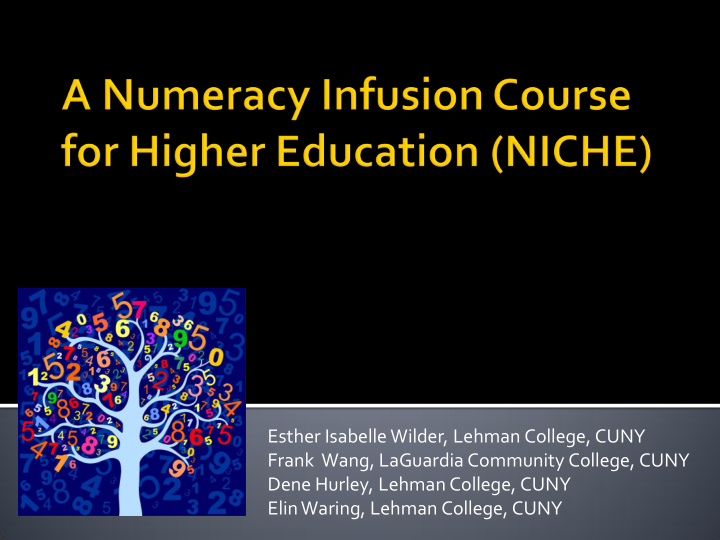



Esther Isabelle Wilder, Lehman College, CUNY Frank Wang, LaGuardia Community College, CUNY Dene Hurley, Lehman College, CUNY Elin Waring, Lehman College, CUNY
Jews are slightly more 1. likely to get cremated than Hindus. Protestants are the 2. religious group most likely to get cremated. 3% of Jews chose to get 3. cremated. All of the above. 4. None of the above. 5.
MAA (1998) reports that colleges must: treat QL as a necessary goal for graduates, expect every graduate to apply simple mathematical methods to the solution of real-world problems, devise and establish QL programs that consist of a foundation experience as well as a continuation experience, and accept responsibility for overseeing their QL programs through regular assessments. Research emphasizes the need to infuse QR throughout the curriculum.
59% of CUNY students are female. 57% are black, Hispanic, or American Indian/Native American. Nearly 30% are 25 or older. 54% have household incomes of less than $30,000. 44% are first-generation students. Many have weak quantitative skills and high levels of math phobia.
Brings together together faculty from a wide range of CUNY schools. Teaches faculty best practices for responding to the QL needs of CUNY students. Gained the support of the National Science Foundation in the fall of 2011 (TUES #1121844). Builds upon a QR initiative at Lehman College/CUNY.
In both years, 100% of participants indicated that an “interest in [the] workshop topic” was a very important reason for their participation. 100% pointed to a “concern for students.” Faculty networking, a “convenient time,” and financial incentives were also identified as important.
First session: 60% of faculty agreed that they had a “good understanding of what Quantitative Reasoning is.“ End of workshop: 100% agreed. September 2011, 80% of participants felt "confident in [their] Quantitative Reasoning skills.“ End of the year: 100% felt confident. From the first session to the last, the percentage of faculty who "place a heavy emphasis on QR in [their] course instruction" rose from 40% to 80%.
Pedagogical strategies emphasized as most important for teaching QR: active engagement in data analysis, pairing QR with writing and/or critical reading, the revision of QR assignments, the assessment of QR learning, and the use of computer software such as Excel. These are the same strategies that faculty plan to use in their teaching. Written comments show strong emphasis on assessment and infusion throughout the curriculum.
Most important elements of QR instruction: wide and multidisciplinary QR participation the blending of QR instruction and writing instruction a screening test that assesses students’ QR skills a QR tutoring center regular assessment of student learning a standard set of QR learning objectives a foundational QR course.
2011-2012 QR Workshop Based on the chart, which of the following is true? African Americans were twice as likely to be cremated than Asians (n=0; 0%) Asians and Hispanics were equally liked to be cremated? (n=0; 0%) On average, 3 of every 100 cremations were among Hispanics. (n=5; 50%) Both (a) and (b) (n=0; 0%) All of the above (n=5; 50%)
2011-2012 and 2012- 2013 QR Workshops Based on the chart, which of the following is true? Jews are slightly more likely to get cremated than Hindus. (n=0; 0%)(n=0; 0%) Protestants are the religious group most likely to get cremated. (n=2; 20%)(n=4; 29%) 3% of Jews chose to get cremated. (n=1; 10%)(n=1; 7%) All of the above (n=0; 0%)(n=4; 29%) None of the above (n=7; 70%)(n=5; 36%)
1. No 64% 2. Yes 29% 3. Not sure 7%
Key Learning Outcomes: apply QL/QR within a disciplinary context; articulate QR learning goals that reflect best practices; identify and implement best practices for teaching QR: active learning, collaborative student learning, writing with numerical information, etc.; adapt and implement strategies for incorporating QR into course instruction; and assess the effectiveness of QR initiatives and use the results to improve instruction.
Please visit us at our NICHE web site, https://serc.carleton.edu/NICHE/
Recommend
More recommend